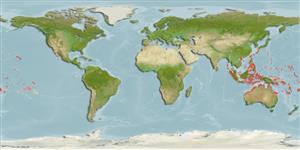>
Blenniiformes (Blennies) >
Blenniidae (Combtooth blennies) > Salariinae
Etymology: Entomacrodus: Greek, ento = inside + Greek, makros = big + Greek, odous = teeth (Ref. 45335); caudofasciatus: Name from Latin 'cauda' for tail and 'fasciatus' meaning with bars, referring to the caudal-fin color pattern of the species (R. Bajol, pers. Comm. 11/14).
More on author: Regan.
Environment: milieu / climate zone / depth range / distribution range
Ecologia
marino associati a barriera corallina; distribuzione batimetrica 0 - 3 m (Ref. 30874). Tropical; 32°N - 31°S
Indo-Pacific: Andamans to Ducie Islands, north to southern Japan, south to Cocos-Keeling, Kermadec, and Rapa Islands; Belau and Marshall Islands in Micronesia.
Size / Peso / Age
Maturity: Lm ? range ? - ? cm
Max length : 6.2 cm SL maschio/sesso non determinato; (Ref. 1602)
Short description
Chiavi di identificazione | Morfologia | Morfometria
Spine dorsali (totale) : 13; Raggi dorsali molli (totale) : 14 - 16; Spine anali: 2; Raggi anali molli: 15 - 17.
Facultative air-breathing (Ref. 126274); Adults are found along rocky intertidal shorelines, benches, outer reef flats, and reef margins subject to some degree of wave action. Feeds on filamentous algae (Ref. 89972). Oviparous. Eggs are demersal and adhesive (Ref. 205), and are attached to the substrate via a filamentous, adhesive pad or pedestal (Ref. 94114). Larvae are planktonic, often found in shallow, coastal waters (Ref. 94114).
Life cycle and mating behavior
Maturità | Riproduzione | Deposizione | Uova | Fecundity | Larve
Oviparous, distinct pairing (Ref. 205).
Myers, R.F., 1991. Micronesian reef fishes. Second Ed. Coral Graphics, Barrigada, Guam. 298 p. (Ref. 1602)
IUCN Red List Status (Ref. 130435: Version 2024-2)
Threat to humans
Harmless
Human uses
Strumenti
Special reports
Download XML
Fonti Internet
Estimates based on models
Preferred temperature (Ref.
123201): 24.7 - 29.3, mean 28.5 °C (based on 1763 cells).
Phylogenetic diversity index (Ref.
82804): PD
50 = 0.5000 [Uniqueness, from 0.5 = low to 2.0 = high].
Bayesian length-weight: a=0.00776 (0.00356 - 0.01695), b=3.00 (2.81 - 3.19), in cm total length, based on LWR estimates for this (Sub)family-body shape (Ref.
93245).
Trophic level (Ref.
69278): 2.0 ±0.00 se; based on food items.
Resilienza (Ref.
120179): Alto, tempo minimo di raddoppiamento della popolazione meno di 15 mesi (Preliminary K or Fecundity.).
Fishing Vulnerability (Ref.
59153): Low vulnerability (10 of 100).
Nutrients (Ref.
124155): Calcium = 234 [108, 447] mg/100g; Iron = 1.01 [0.54, 1.87] mg/100g; Protein = 17.8 [16.5, 19.1] %; Omega3 = 0.0749 [, ] g/100g; Selenium = 16.5 [7.1, 41.0] μg/100g; VitaminA = 140 [33, 612] μg/100g; Zinc = 3.29 [2.05, 5.07] mg/100g (wet weight);
